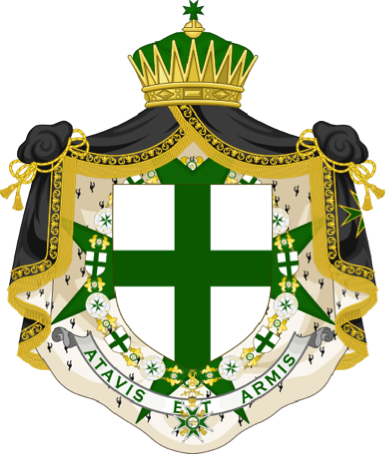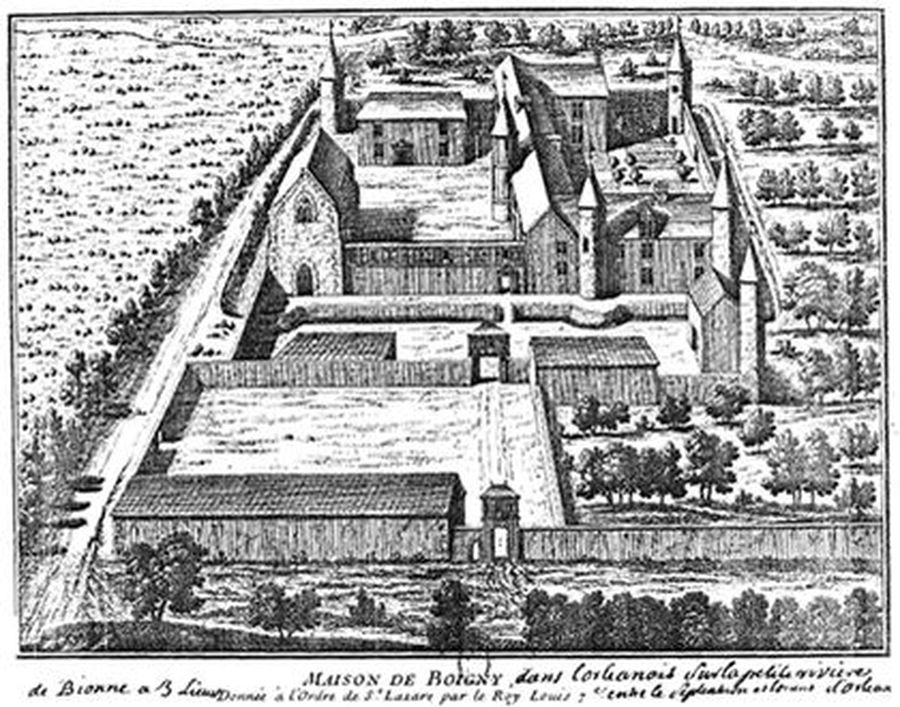The History of the Order (14th - 15th Centuries)
Following the expulsion of the Christian forces from the Holy Land after the fall of Acre, the Order of Saint Lazarus restationed its headquarters at Boigny near Orléans in France, the principal house in France of the order of St Lazarus. The property at Boigny was originally donated to the Order by King Louis VII (1137-80) after his return from the Crusade in 1154 and erected as a barony in 1288.[1] The other houses in other European lands remained subservient to the mother house in France. At some date after 1291, the master-general during this difficult period for the order was a Frenchman, Thomas de Sainville who transferred the centre of operations to France.[2] This transfer may have happened soon after 1307, the date of King Philip IV's (1285-1314) attack on the Templars, because in the following year, the king took the order of St Lazarus under his personal protection.[3]
By the 15th century, the scourge of leprosy in Europe had markedly diminished and the Order of Saint Lazarus had slowly lost its raison d’être. After a long period in office, Sainville died in 1312. He had seen the order undergo fundamental change but to his credit, the order at least survived during this volatile period of the order's history. His successors were much less successful in carving out a new niche for themselves in the context of the continuation of the Crusade or in developing their hospitaller activities. They did not follow the lead of the order of St John in setting up a Mediterranean base or fitting out galleys to pursue a naval war against the Infidel; nor did they act purposefully to create a fresh start around the proposals of Clement IV's bull.[4] Demoralised because of their expulsion from the Holy Land and no doubt vilified by some because of the events of the lepers' plot of 1321 [5], the Lazarites staggered on.[6] The deterioration of the order continued without purpose and it was only a matter of time before fragmentation and schism became the evident for the order. The French orientation became deeply resented by the English at Burton Lazars [7] and Capua, located in southern Italy was simply too far away, too culturally distinct for effective management from Boigny. During this time, both Boigny and Capua claimed leadership and other provinces simply went their own way amid the general confusion.[8] In addition, tensions between the English and the French escalated once King Edward III crossed the English Channel with an army in 1338 commencing a conflict that lasted for more than one hundred years, therefore, any connection with Boigny was viewed with suspicion. Other political machinations over the following years culminated during the time of the order's master, Sir William Sutton where riding high in favour of King Edward IV in 1479, in combination with a further grant from Pope Sixtus IV (1471-84) released Burton Lazars from any subjection to the French mother house.[9] Pope Innocent VIII (1484-92) in 1489 attempted to transfer the holdings of the Order of Saint Lazarus with the Hospitallers of the Order of Saint John then stationed in Rhodes, in effect amalgamating the two Orders. But, with the support of King Charles VIII (1483-98), and the resistance by a powerful faction of French knights of St Lazarus, the bulls were finally annulled by Pope Pius IV (1559-65) in 1517.[10]
- V.G. Berry (ed.), Ordo de Deuil, De Profectione Ludovici VII inn orientem (New York, 1948), pp. 16-17; M. Barber. 'The Order of Saint Lazarus and the Crusades'. The Catholic Historical Review, 80, no.3 (July 1993). p. 447.
- K.P. Jankrift, 'Die Leprosenbruderschaft des Heiligen Lazarus zu Jersalum un ihre Ältesien Statuten', in G. Melville (ed.), De Ordine Vitae: zu Normvorstellungen, Organisationsformen und Schriftgebrauch im mittelalterlichen Ordenswesen, Vita Regularis, 1 (Münster, 1996). p.86.
- Marcombe, David. Leper Knights - The Order of St. Lazarus of Jerusalem in England, c.1150-1544,. Boydell Press. 2004. ISBN: 978 1 84383 067 2. p.21; P. Bertrand de la Grassière, L'Ordre Militaire et Hospitaler de Saint-Lazare de Jérusalem, (Paris, 1960), pp.25-6; R. Bagdonas, The Military and Hospitaller Order of St Lazarus of Jersalem: its history and work, (nd), p. 15. For the circumstances of Philip IV's vendetta against the Templars, see M. Barber, The Trial of the Templars (Cambridge, 1978). Pierre Dubois was critical of the military orders and wanted them brought together under the authority of the crown. Jankrift, Leprose, p.111.
- Ibid, p.21.
- McVaugh, Michael R. (2002). Medicine Before the Plague: Practitioners and Their Patients in the Crown of Aragon, 1285–1345. Cambridge University Press. p. 220. ISBN 0521524547. The lepers' plot was an alleged conspiracy of French lepers to spread their disease by contaminating well water with their powders and poisons.
- Marcombe, Leper Knights, p.21; K.P. Jankrift, 'Die Leprosenbruderschaft des Heiligen Lazarus zu Jersalum un ihre Ältesien Statuten', in G. Melville (ed.), De Ordine Vitae: zu Normvorstellungen, Organisationsformen und Schriftgebrauch im mittelalterlichen Ordenswesen, Vita Regularis, 1 (Münster, 1996). pp. 111, 116-19.
- Nichols, John (1795). The History and Antiquities of the County of Leicester. Leicester: John Nichols. Roger de Mowbray, Lord of Montbray (c.1120–88), was an English noble and soldier who made a generous donation of two carucates of land (c.240 acres), a house and two mills to the Order of St Lazarus, headquartered at Burton St Lazarus Hospital in Leicestershire, after his return from the crusades in 1150.
- Ibid, p.21; P. Bertrand de la Grassière, L'Ordre Militaire et Hospitaler de Saint-Lazare de Jérusalem, (Paris, 1960), pp.26-7.
- Calendar of Papal Registers Relating To Great Britain and Ireland, Volume 13, 1471-1484, p.3. 1479. 16 Kal. Aug. (17 July.) St. Peter's, Rome. (f. 77r.). For convenience, an extract of the regesta is the following:
Exemption, at the recent petition of William, master, and the brethren of the Lazar house or hospital of Burton, in the diocese of Lincoln (fn. 1) (containing that although the said house or hospital is said to be dependent on the house of Boigny (de Boigniaco) of the said order, in the diocese of Orleans, the master and brethren of Burton have for about 80 years behaved as though free from any obedience to Boigny; that the two houses are so much apart that if the master and brethren of Burton had to have recourse to Boigny for all their affairs, its revenues would hardly suffice therefor, and that such recourse would moreover be unsafe, inasmuch as there have long been wars and dissensions between the English and French; alleging, furthermore, that Nicholas V made a similar grant to the master and brethren of the house of St. Anthony, London, O.S.A. (fn. 2)), of the said house of Burton, and its master and brethren, priests, clerks, scholars, poor, servants, etc., of both sexes, and its goods etc., from all jurisdiction etc., of the master and brethren of Boigny, and also of all patriarchs, archbishops, bishops, judges ordinary and any others, the said house of Burton being hereby taken under the protection of the pope and the apostolic see, and decreed to be solely and immediately subject thereto, the master to be freely elected by the brethren from amongst themselves, and to require no confirmation, and to have power to admit new brethren, etc.; with mandate executory hereby to the archbishop of Canterbury and the bishops of London and Rochester...
- C.G. Herbermann et al. (eds), The Catholic Encyclopedia, 9, London, 1910), p. 97.; R. Bagdonas, The Military and Hospitaller Order of St Lazarus of Jersalem: its history and work, (nd), p.16.




